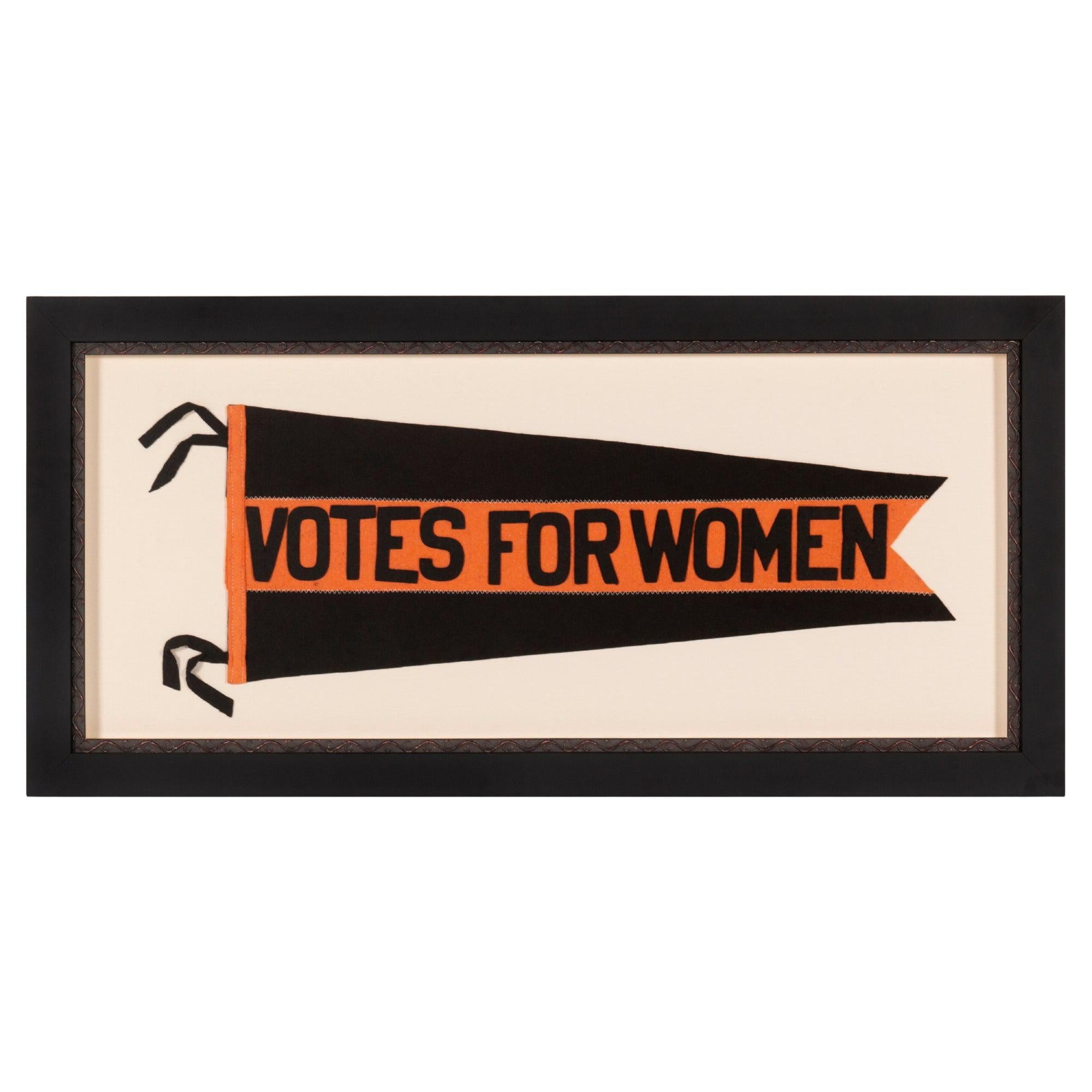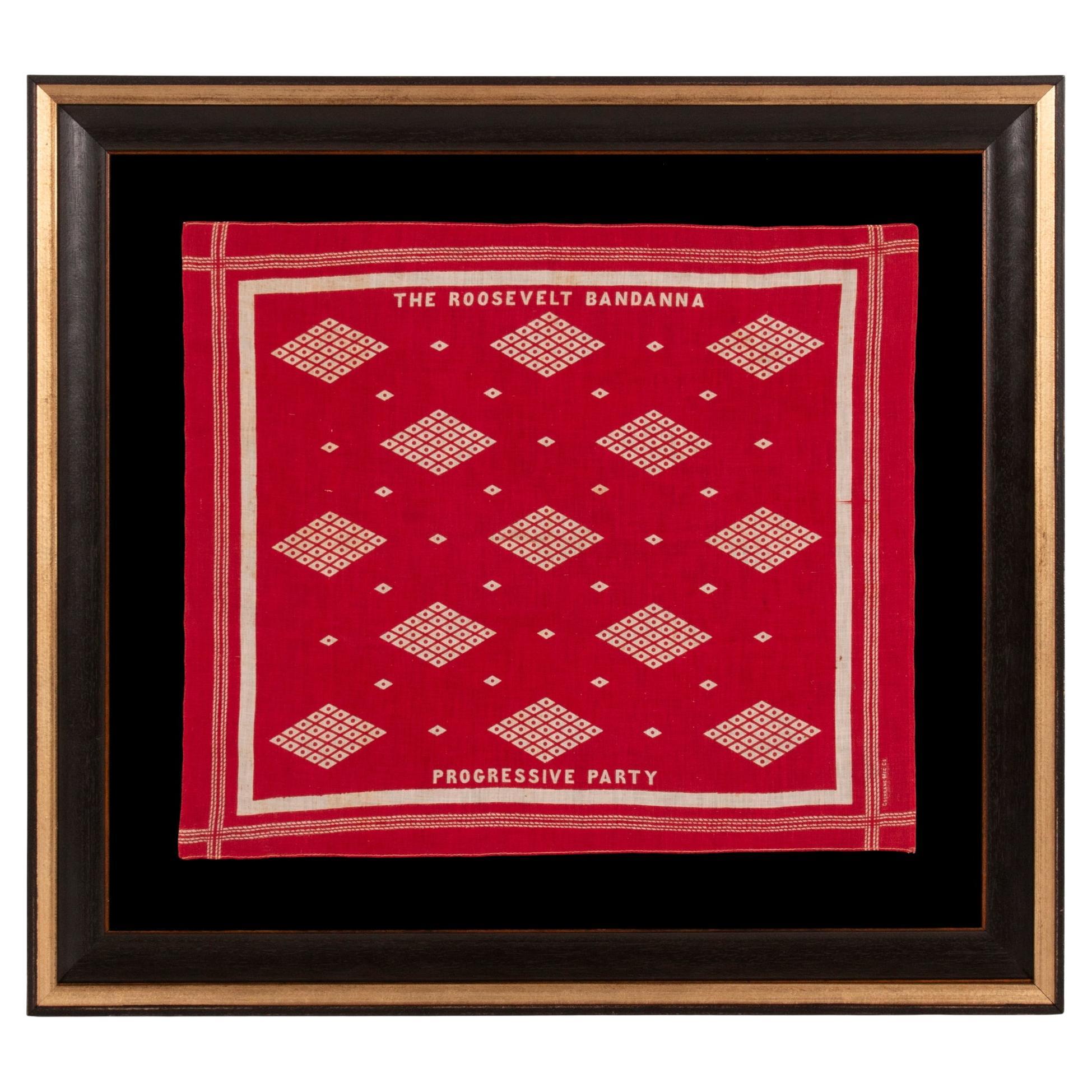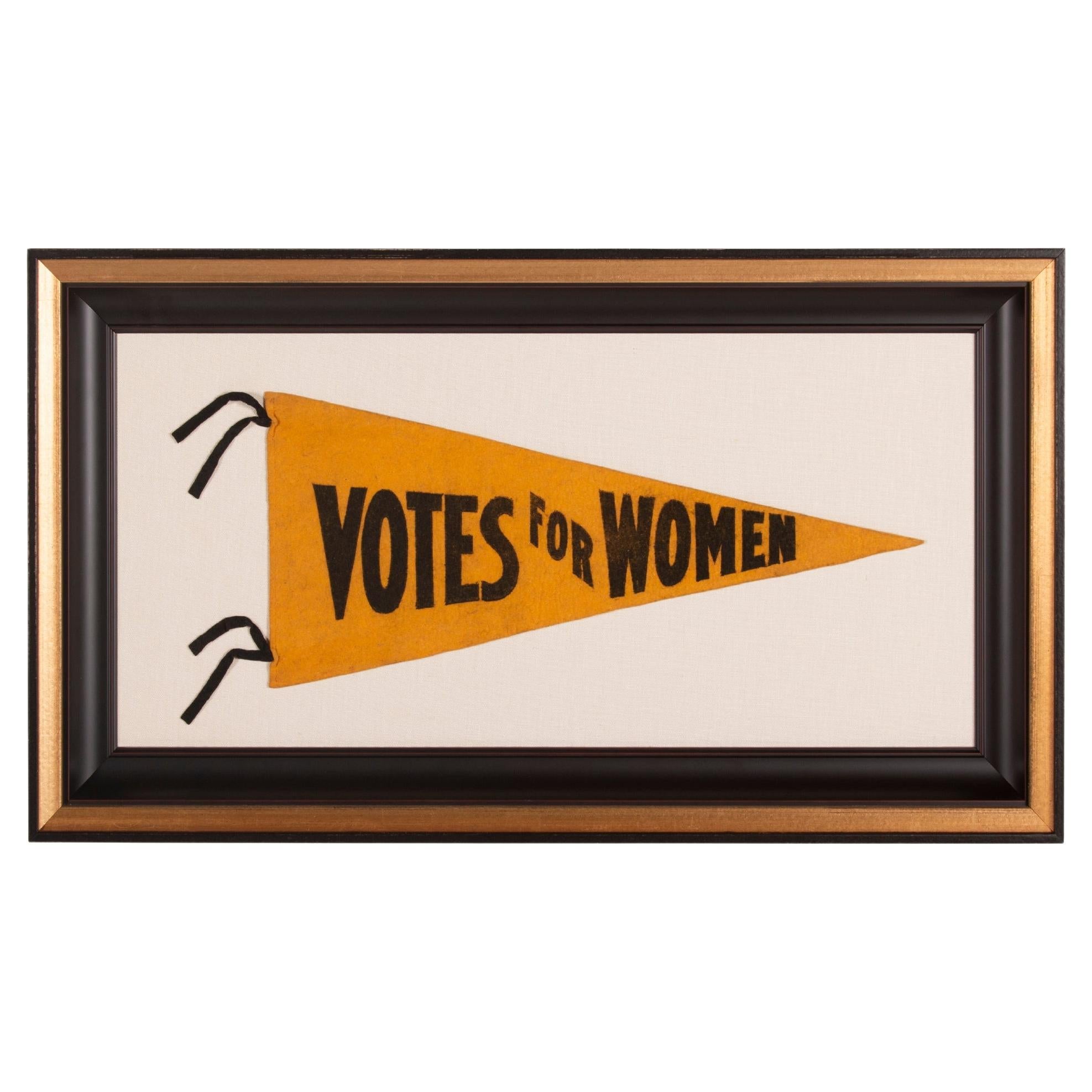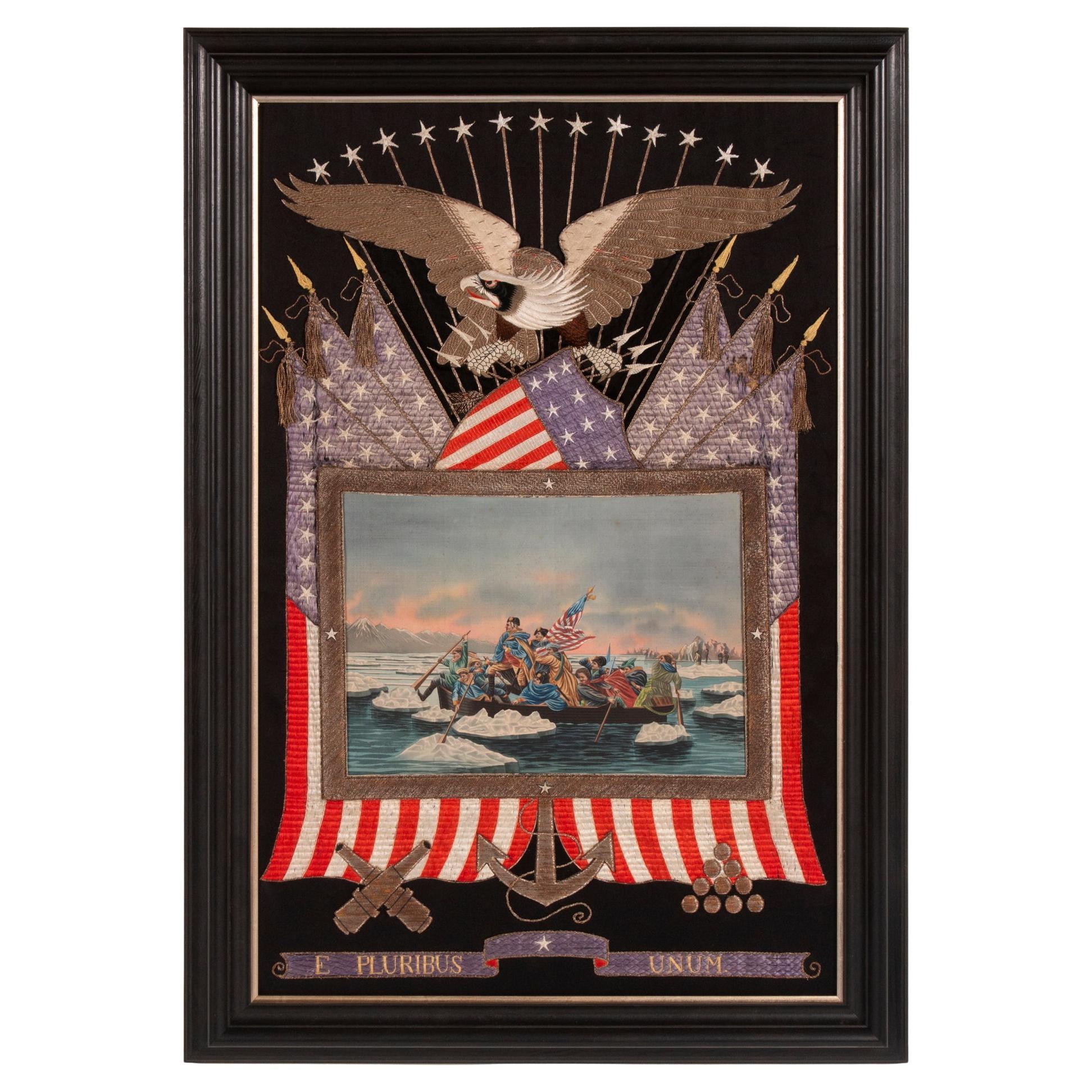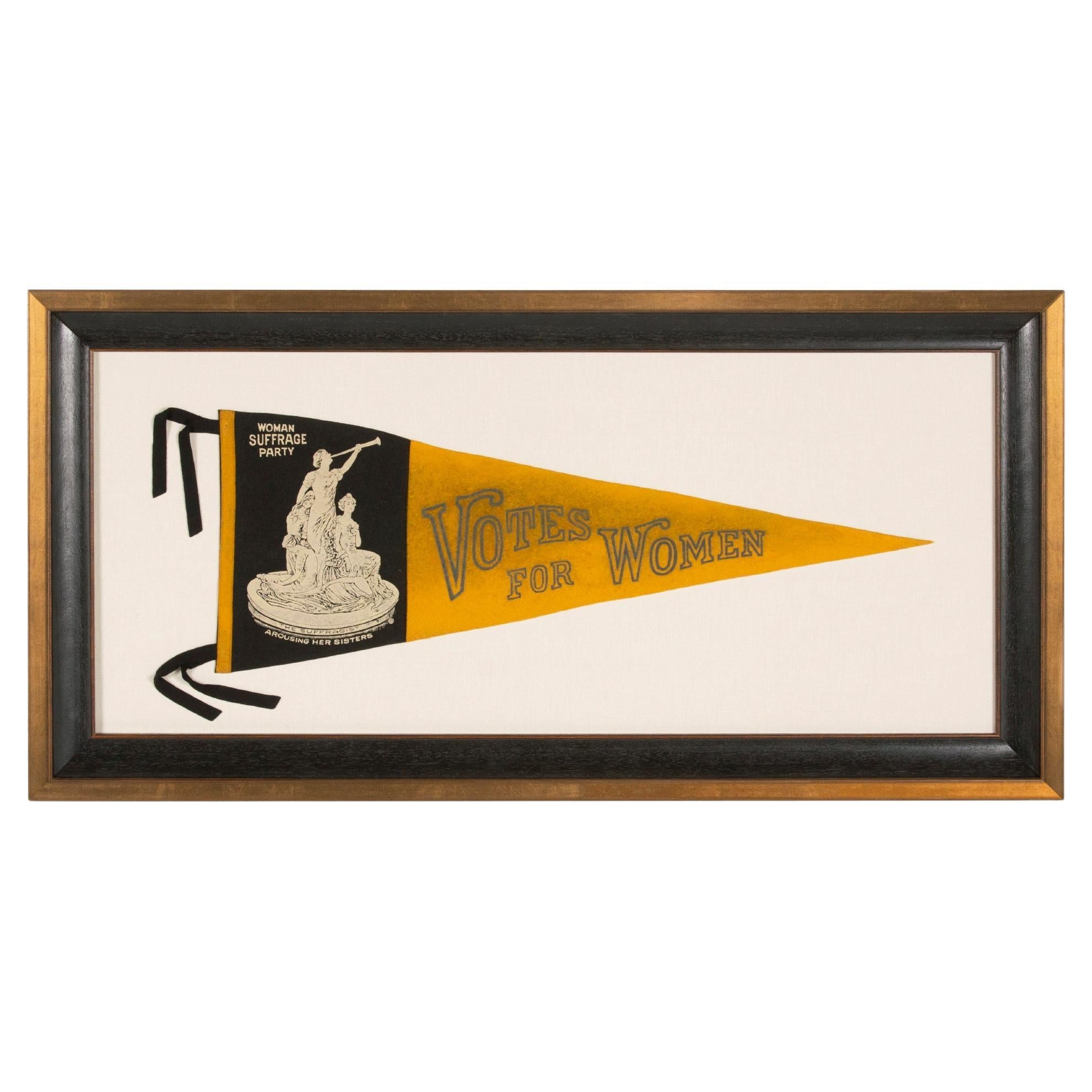Items Similar to Rare Suffragette Armband in Golden Yellow Felt, ca 1912-1919
Want more images or videos?
Request additional images or videos from the seller
1 of 5
Rare Suffragette Armband in Golden Yellow Felt, ca 1912-1919
About the Item
RARE SUFFRAGETTE ARMBAND IN GOLDEN YELLOW FELT, ONE OF ONLY TWO EXAMPLES THAT I HAVE ENCOUNTERED IN THIS COLOR & THE ONLY ONE IN THIS EXACT STYLE; MADE circa 1912-1919:
Wide, felt armband, in the traditional golden yellow of the American Suffrage movement, with printed black text that reads: “Votes for Women.” Though akin to the most often encountered forms of yellow felt textiles produced for Suffragettes, this example is particularly special. In spite of it being a form that a casual observer might expect to have been readily produced, this is the only one I have seen in this exact form, and one of just two in this color that I have seen in any form that were purposefully sewn in this capacity, probably by the maker. The other was very similar, but with a different manner of lettering.
Golden yellow was the customary color of the suffrage movement in America, a tradition begun with the first actual campaign to give women the right to vote. This took place in 1867 in Kansas, the first state to hold a referendum on the issue, when suffragists Susan B. Anthony and Carrie Stanton focused their efforts there and wore sunflowers—the state flower—in a show of support, as well as yellow ribbons. The flower was an appropriate emblem for a rising sun and growth, which led to its use in other states. The color would carry through over to many other objects employed in the campaign for years to come. In England, green, white, and purple / violet were introduced in 1908 and became the colors of the movement, which gave way to a nice acronym for “Give Women the Vote.” Various groups used these colors also, in the States, sometimes substituting golden yellow for green.
Votes for Women textiles of all kinds are particularly scarce and sought-after. Due to its exceptional rarity, this is a great relic of the suffrage period.
Mounting: The textile was mounted and framed within our own conservation department, which is led by expert staff. We take great care in the mounting and preservation of flags and related textiles and have framed thousands of examples.
The solid walnut molding dates to the period between 1860 and 1880, has a fluted edge, and retains its original gilded liner. The textile was fitted around a custom-made form. The background fabric is 100% cotton twill, black in color, that has been washed and treated for colorfastness. A deep shadowbox was created to accommodate the textile. The glazing is U.V. protective glass.
Condition: There is a tiny nick along the top edge and there are pinprick-sized dots of staining in limited areas. Some fading.
Frame Size (H x L): 11.25" x 16"
Flag Size (H x L): 3.75" x 8.5"
- Dimensions:Height: 11.25 in (28.58 cm)Width: 16 in (40.64 cm)Depth: 3 in (7.62 cm)
- Materials and Techniques:
- Place of Origin:
- Period:1910-1919
- Date of Manufacture:1912-1919
- Condition:See Item Description.
- Seller Location:York County, PA
- Reference Number:
About the Seller
5.0
Recognized Seller
These prestigious sellers are industry leaders and represent the highest echelon for item quality and design.
Established in 1991
1stDibs seller since 2008
61 sales on 1stDibs
Typical response time: 10 hours
- ShippingRetrieving quote...Ships From: York County, PA
- Return PolicyThis item cannot be returned.
More From This SellerView All
- Swallowed Tailed, Suffragette Pennant in Black and Orange, ca 1912-1920Located in York County, PALarge, swallow tailed, suffragette pennant in a black & orange color combination unique to this example, with applied lettering that reads "Votes for Women” down a wide, central stri...Category
Mid-20th Century American Political and Patriotic Memorabilia
MaterialsFelt, Cotton
- Violet & Yellow Suffragette Parade Banner, Ca 1910-1920Located in York County, PARare violet & yellow Suffragette parade banner, the plate example illustrated in the text reference on the subject, made ca 1910-1920. Hand-painted banners...Category
Early 20th Century Political and Patriotic Memorabilia
MaterialsSilk
- 1912 Roosevelt Turkey Red Bandana, ca 1912Located in York County, PATurkey red bandanna, made for the 1912 presidential campaign of teddy Roosevelt, when he ran on the independent, progressive party (bull moose) ticket Printed cotton kerchief, made for the 1912 presidential campaign of Theodore Roosevelt when he ran on the Progressive Party ticket (a.k.a., the Bull Moose campaign). This graphic textile, in a classic, western style, typical of the iconic red bandanna, is indicative of both the Republican Party in the late 19th century, and T.R.’s love of the American West. In this example, a geometric design with diamonds, surrounded by multiple, linear borders, is accompanied by the following text along the top and bottom that reads: “The Roosevelt Bandanna” and “Progressive Party,” respectively. A maker’s mark in the lower right corner reads “Cochranes Mfg. Co.” Cochrane’s was known for their long-lasting, red dye process, called “Cochrane’s Turkey Red.”. It was really a process, as opposed to a dye itself, to which the name applied. The dye was actually a derived from a synthetic colorant called “alizarin,” imported by Alexander Cochrane’s family, who emigrated to the United States from 1847, and owned a chemical company in Massachusetts that produced the dye. The fabrics were produced by the family of John Cochrane, who emigrated from Renfrewshire, Scotland in 1844. Both families, who resided in Malden, Massachusetts initially, traced their ancestry to Barrhead, Scotland, in the heart of the textile-producing region, near Glasgow and Paisley. It was in Glascow that Turkey Red printed bandannas are said to have originated, in the shop of Henry Monteith & Company, in 1802.* TR's decision to enter the 1912 election was not exactly popular among many of his friends and former supporters. His participation manifested into a unique political incident, in which the independent, Roosevelt, beat out a major party ticket, garnering 27.4% of the vote. At the same time, however, he lost the White House, not only for himself, but for his former Republican friends as well, by dividing support between his own candidacy and that of incumbent President William Howard Taft...Category
Vintage 1910s American Political and Patriotic Memorabilia
MaterialsCotton
- "Votes for Women: Suffrage Pennant ca 1912-1920Located in York County, PAAmerican Suffrage movement pennant, with a standard, triangular taper. Made of yellow felt, with tapered letters that read simply: "Votes for Women," bo...Category
Early 20th Century American Political and Patriotic Memorabilia
MaterialsFelt
- Elaborate Sailor Souvenir of Washington Crossing the Delaware, ca 1885-1912Located in York County, PAElaborate sailor’s souvenir embroidery from the orient with a beautiful hand-painted image of Washington crossing the Delaware, surrounded by a large eagle, federal shield, crossed flags, a cannon, cannonballs, and anchor, circa 1885-1910: Between roughly 1880 and 1915, American sailors visiting the orient could obtain beautiful needlework embroideries on shore, with patriotic American themes. These extraordinary works of art were acquired as mementos of a long voyage, often with the hope that they might be presented as gifts for loved ones and friends. Using silk floss, elaborately embellished with both silver and gold metallic bullion thread...Category
Antique Late 19th Century Asian Political and Patriotic Memorabilia
MaterialsSilk
- Carrie Chapman's "Woman Suffrage Party" Pennant, New York City, ca 1912-1920Located in York County, PA"VOTES FOR WOMEN" PENNANT WITH AN IMAGE OF A 1911 STATUETTE CALLED "SUFFRAGIST" BY ELLA BUCHANNAN, MADE FOR CARRIE CHAPMAN CATT'S "WOMAN SUFFRAGE PARTY" OF NEW YORK CITY, CA 1912-20 ...Category
Mid-20th Century American Political and Patriotic Memorabilia
MaterialsCotton
You May Also Like
- Very Rare West Riding Constabulary Cast Iron Wall PlaqueLocated in Chillerton, Isle of WightVery rare west riding constabulary cast iron wall plaque This branch of the British police force was established in 1825, Yorkshire was divided into ...Category
Antique 1890s British Colonial Political and Patriotic Memorabilia
MaterialsIron
- William & Mary Rare Pewter Trefid Spoon with Portraits, Circa 1690Located in Bishop's Stortford, HertfordshireVery rare William and Mary pewter trefid spoon the handle molded in relief with portraits and dating from around 1690. The spoon has an elongated rounded ...Category
Antique 17th Century English William and Mary Political and Patriotic Me...
MaterialsPewter
- Rare Monumental 1890 Antique 42 Star United States of America FlagLocated in Dayton, OHMonumental fifteen foot 42 star American flag, circa 1889-1890. The 42-star flag is rare because only a limited number of 42-star flags were produced after Washington became a state on Nov. 11, 1889. But it takes a more intimate knowledge of flag trivia to know just why it happened this way. White stars are added to the blue field of the star-spangled banner on the Fourth of July after a state is admitted to the union. In the fall of 1889, several western territories became states. Dakota was admitted, and then split into North and South Dakota, on Nov. 2, 1889, which made them state and star numbers 39 and 40. Montana was named the 41st state on Nov. 8, followed by Washington, on Nov. 11. Only a few flag manufacturers began producing 42-star flags before the official addition of the 42nd star on July 4, 1890. Those who tried to jump the gun by being the first to produce an up-to-date flag were surprised when Idaho was admitted to the United States on July 3...Category
Antique 1890s American Classical Historical Memorabilia
MaterialsCotton
- 36-Star Printed American Flag, Rare Haloed Star Medallion, Circa 1865Located in Colorado Springs, COThis 36-star flag has stars arranged in a gorgeous and highly desirable medallion pattern. This particular medallion includes a large haloed star in the middle, two rings of stars s...Category
Antique 1860s American Political and Patriotic Memorabilia
MaterialsFabric
- 46-Star American Flag Printed in Drum Star ConfigurationLocated in Colorado Springs, COThis is an original 46-Star American parade flag, celebrating Oklahoma statehood. Each star on the flag's canton represents a state in the Union at the time. The official flag design would update every July 4th, to include any new states added to the Union in the past year. Oklahoma, the 46th state, entered the Union on November 16, 1907. As such, this 46–star flag was the official flag of the United States from July 4, 1908, until July 4, 1912. The silk flag has a dark blue canton with 46 white printed stars. The stars are printed in an 7-8-8-8-8-7 row configuration, or “Drum design.” The flag design is completed with 13 alternating red and white stripes, each stripe representing one of the original thirteen colonies. The land that comprises Oklahoma today was added to the United States as part of the Louisiana Purchase of 1803. Throughout the 19th century, the U.S. government relocated Indian tribes from the southeastern United States to the area, and by 1900, over 30 Indian tribes had been moved to what was originally called the Indian Territories. At the same time, ranchers in Texas began to move into the area in search of new pasture lands. Although stipulations in the Indian Relocation Act agreed that the land would forever be Indian Territory, the promise of fertile farmland trumped the government’s promise of sovereignty. On April 22, 1889, they opened the land to settlement by homesteaders, creating a land run in which settlers, called “Boomers,” were allowed to cross the Texas or Arkansas border at a particular hour to claim homesteads. Settlers who illegally crossed the border earlier to stake prime land were called “sooners,” which eventually became the state’s nickname. Wagons and the Santa Fe railroad carried cartloads of men and women to blank town sites and building plots, creating ten thousand-people communities in a matter of days. The following year, the region was further divided into Indian Territory and Oklahoma Territory...Category
Vintage 1910s American Political and Patriotic Memorabilia
MaterialsSilk
- US Air Corps in Australia Vintage Military Pennant, circa WWIILocated in Colorado Springs, COPresented is a souvenir felt pennant celebrating the servicemen and women of the U.S. Air Corps who were based in Australia and fought alongside members of the Royal Australian Air Force during WWII. The navy pennant features a printed red outline of the Australian continent with the U.S. Air Corps “wings” superimposed on it. Below, the text reads, “Souvenir of U.S. Air Corps in Australia.” At the very bottom of the pennant is the U.S. Air Corps symbol. Framed according to archival standards, this pennant symbolizes the collaborative partnership between the United States and Australia during the height of the Second World War in the Pacific Theater. Following the swift Japanese conquest of the Philippines and East Indies in late 1941, the remaining servicemen of the United States Army Air Force in the Pacific eventually relocated to Australia, to join other US and Australian units, including the Fifth Air Force, and regroup. The Fifth Air Force was placed under the command of Major General George Kenney in July of 1942. Their new goal was to seize air superiority over New Guinea and gain back air coverage over the Solomon Sea. General Kenney worked with U.S. Army General MacArthur...Category
Vintage 1940s Australian Historical Memorabilia
MaterialsFelt
